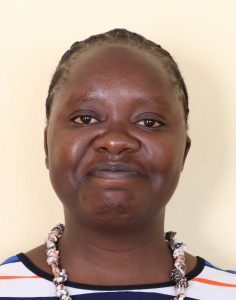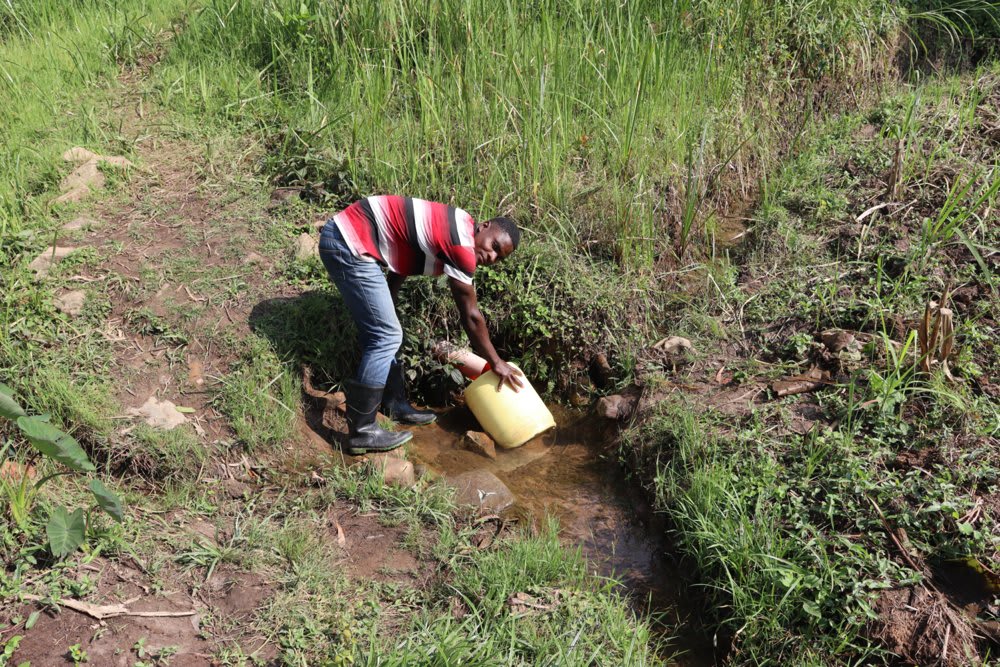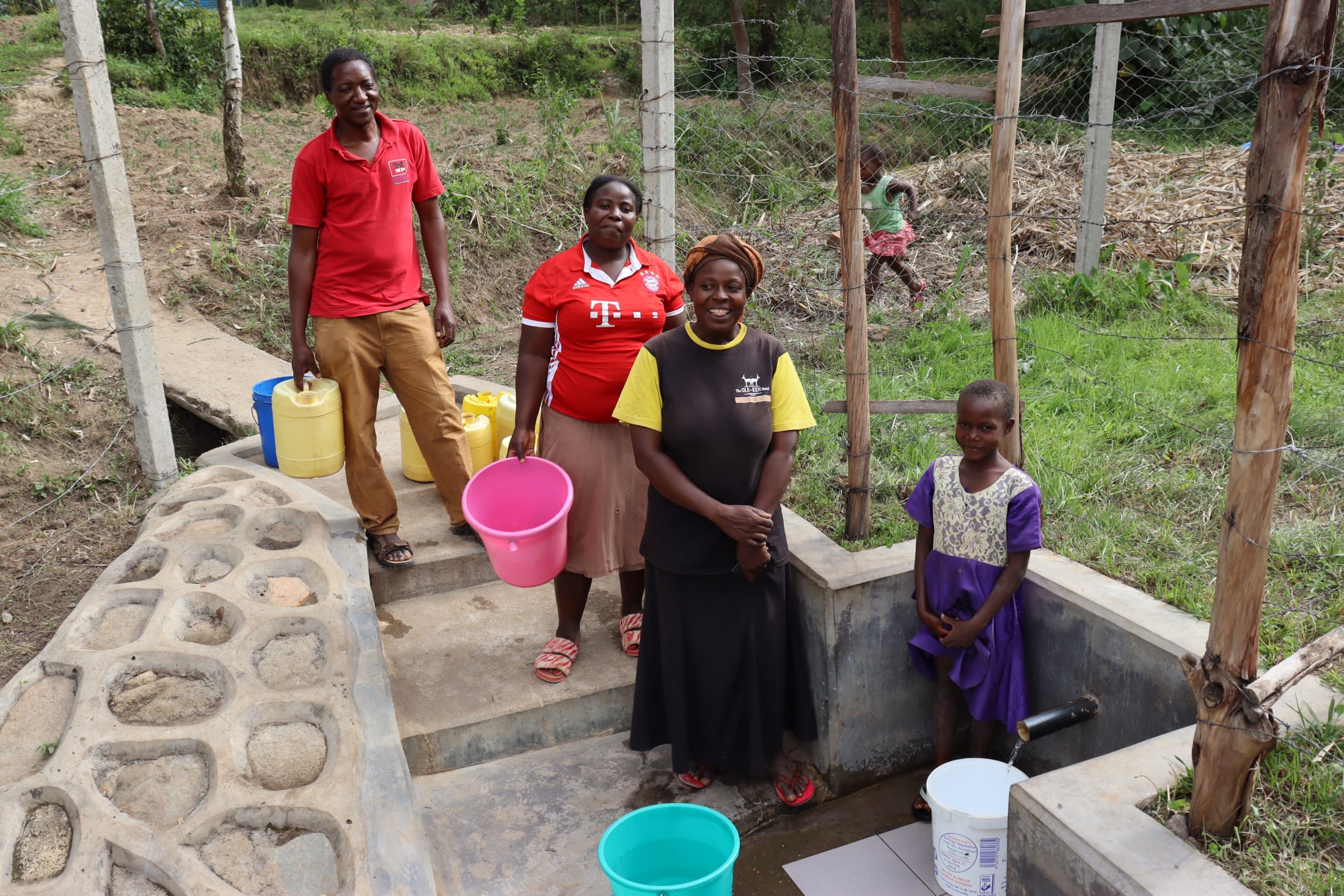June, 2021: Violet Inganji Spring Project Complete!
Bukhaywa Community now has access to clean water! We transformed Violet Inganji Spring into a flowing source of water, thanks to your donation. Our team protected the spring and trained the community on improved sanitation and hygiene practices, including COVID-19 prevention.

Posing at the completed spring, including Madam Violet Inganji, second from left.
"Before, I would suffer from waterborne diseases. Most money would be used to treat the diseases. Now, with clean water, the money can instead be put into business and other ventures," said Violet Inganji, the namesake of the spring and the elected Secretary of the water user committee.
"Now, with this water point, it means less time at the water point. I can now engage in other activities that I have intended to venture into, but I couldn't because most time was spent fetching water."

Violet Inganji fetches water from the spring.
Younger community members were just as excited about the new water point.
"Now, with access to clean water, I am no longer worried about waterborne diseases. I can easily go about my day-to-day cleaning activities with no problems. Before, I would frequently get sick, and that would mean money being spent on me. But now, I am assured of clean, safe water," said Brian, nearly an adult and the elected Sanitation Officer of the water user committee.
"Now work has been made easy. I can easily go about with cleaning duties without much of a hassle like before. Also, with extra time on my hands, I can engage in other activities that I have been looking forward to," Brian added.

Brian pours water to celebrate the spring.
Preparing for Spring Protection
Community members worked together to source and carried all locally available construction materials to the spring. These included bricks, sand, stones, and fencing poles. Some people also chiseled away at large stones to break them down into the gravel. Because people have to carry most items by hand, the materials collection process can take anywhere from a few weeks to months.
When everything was prepared, we sent a lorry to the community to deliver the rest of the construction materials, including the cement, plastic tarps, and hardware. Then, our artisan and field officers deployed to the spring to begin work. Individual households provided meals throughout each day to sustain the work team.
From Open Source to Protected Spring: A Step-by-Step Process
At last, it was time to dig in at the spring! Women and men lent their strength to the artisan each day to help with the manual labor. First, we cleared and excavated the spring area. We dug a drainage channel below the spring and several surface runoff diversion channels above and around the spring. These help to divert environmental contaminants carried by the rains away from the spring.

Excavation
To ensure community members could still fetch water throughout the construction process, we also dug temporary diversion channels from the spring’s eye around the construction site. This allowed water to flow without severely disrupting community members’ water needs or the construction work.

Pouring the foundation
Excavation created space for setting the spring’s foundation made of thick plastic tarp, wire mesh, concrete, and waterproof cement. After setting the base, we started brickwork to build the headwall, wing walls, and stairs.

Bricklaying
Next, we began one of the most crucial spring protection steps to ensure a fully functional water point: setting the discharge pipe. The discharge pipe has to be low enough in the headwall so that the water level inside never rises above the spring’s eye, yet high enough to leave eighteen to twenty inches between the pipe and the spring floor. This allows room for the average jerrycan (a 20-liter container) to sit beneath the pipe without making contact.

Setting the pipe
If the discharge pipe were placed too high above the spring’s eye, too much backpressure could force the flow to emerge elsewhere. Too low, and community members would not be able to access the water easily. We embedded the pipe using clay (or mortar when the clay is in short supply) and placed it at a slight incline to ensure water flows in the right direction.

Stone pitching and stairs construction
In coordination with brickwork, we pitched medium to large stones on both sides of the spring’s drainage channel. We then cemented and plastered each stone group into place, forming the rub walls. These help discourage people and animals from standing on that area, which could cause soil erosion and thus a clogged drainage area.

Plastering
We turned to cementing and plastering both sides of the headwall and wing walls with brickwork and stone pitching completed. These finishing layers reinforce the brickwork and prevent water in the reservoir from seeping through the walls. In turn, enough pressure builds in the reservoir box to push water out through the discharge pipe.

Plastering
As the headwall and wing walls were curing, we cemented and plastered the stairs and installed four tiles beneath the discharge pipe. The tiles protect the concrete from the falling water’s erosive force while beautifying the spring and facilitating easy cleaning of the spring floor.
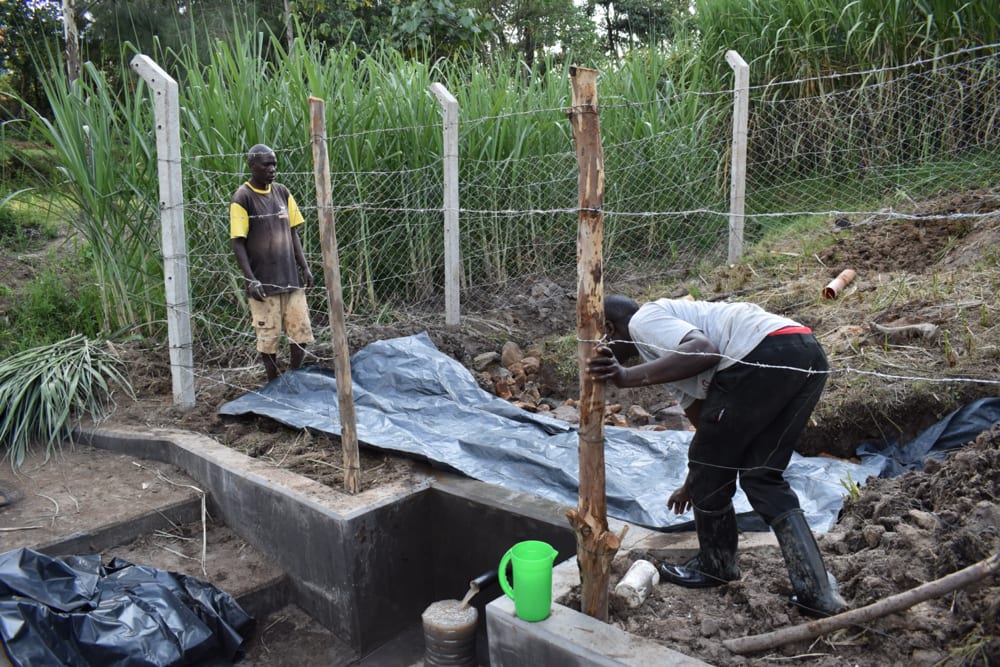
Backfilling
We transitioned to the final stages of construction with the tiles in place - backfilling the reservoir box. First, we cleared the collection box of any debris that may have fallen in since its construction, such as dead leaves or other items. Then we redirected the temporary diversion channels back into the reservoir box, channeling water into this area for the first time. We closed off all of the other exits to start forcing the water through the discharge pipe only.
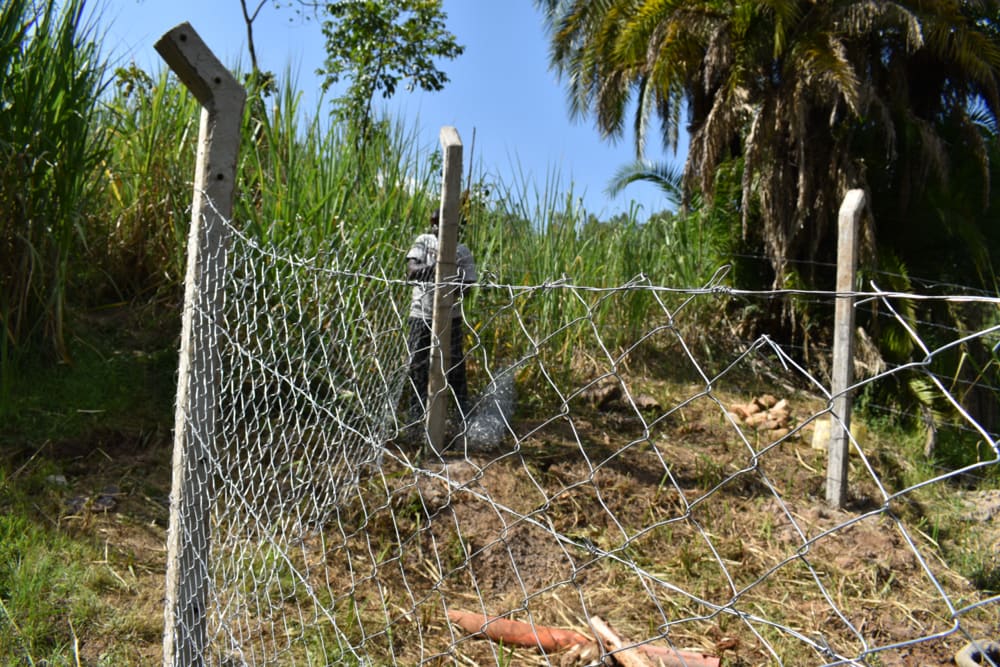
Fencing
With much help from the community, we filled up the reservoir area with the clean and large stones they gathered, arranging them in layers like a well-fitting puzzle. We covered the stones with a thick plastic tarp to minimize potential contamination sources from aboveground, followed by a layer of soil. We piled enough soil on top to create a slight mound to compensate for the backfill’s future settlement.

Planting grass
Community members transplanted grass onto the backfilled soil to help prevent erosion. Finally, the collection area was fenced to discourage any person or animal from walking on it since compaction can lead to disturbances in the backfill layers and potentially compromise water quality.

A woman raises a glass of spring water to celebrate its completion.
The entire construction process took about two weeks of work and patience to allow the cement and plaster to finish curing. As soon as it was ready, people got the okay from our field officers to fetch water. We officially handed over the spring directly following training to mark the community's ownership of the water point. Happiness, thanksgiving, and appreciation were the order of the day flowing in all directions.

Training on Health, Hygiene, COVID-19, and More
Due to the ongoing challenges and restrictions amidst the pandemic, we worked with local leaders and the national Ministry of Health to gain approval for a small group training about health, hygiene, and COVID-19 prevention.
Together with the community, we found their preferred date for training while considering other community calendar events, such as the agricultural season and social events. We requested a representative group of community members to attend training to relay the information learned to the rest of their family and friends.

Physical distancing check at training
When the day arrived facilitators, Jemimah Kasoha and Valian Sachita deployed to the site to lead the event. Thirteen people attended the training, including the Village Health Volunteers and self-help group members. The attendance was lower than expected because one of the community members had recently died, so most people had gone to volunteer their time in the bereaved's home.
We held the training under a tree near the spring. It was a sunny day, so the tree acted as a shade. There was enough light and free circulation of air. Also, the people were able to maintain the physical distance as required by the government.

Handwashing session
Perhaps the most crucial topic of the day was our session on COVID-19 prevention and control. Due to the rampant spread of misinformation about COVID-19, we dedicated time to a question and answer session to help debunk rumors about the virus and provide extra information where needed.
We covered several other topics, including community participation in the project; leadership and governance; personal and environmental hygiene; water handling and treatment; operation and maintenance of the spring; dental hygiene; the ten steps of handwashing, and how to make and use a tippy tap and leaky tin. We held an election for the newly formed water user committee leaders during the leadership and governance session.

On-site training at the spring
We also brainstormed income-generating activities that can be used to start a community savings account for any future minor repairs to the spring and a cooperative lending group to enable members to develop small businesses. This financial management session became the most memorable topic as the participants were eager to know how they could invest and also save their money. One participant shared her experience with table banking in a local women's group, where they save and give loans. They all agreed that it is in those small groups that they can save and borrow to engage in development projects.

Leah Muhonja, Water User Committee Chair
Kitchen gardening was another memorable topic. Most people said they had small pieces of land, so they did not know how they could engage in farming for commercial purposes. But now, with the new knowledge on kitchen gardening, they were all excited about it and willing to give it a try.

Kitchen gardening demonstration
"I have had a very good session today. Everything that has been said and shared is very important. With the new knowledge, I intend to make adjustments in my life which will, in turn, bring a positive impact," said Violet Inganji, the namesake of the spring and the elected Secretary of the water user committee.
"In our homesteads, a number of us had put in place a tippy tap for handwashing purposes, so everyone getting in or out had first to wash their hands. Some of us also would put on masks, especially in public gatherings," Violet said, naming "mask-wearing and how to cough and sneeze" as the most valuable lessons under COVID-19 prevention.

Madam Violet Inganji at training
"Most people still didn't understand the importance of putting on your mask to cover the nose and mouth. Also, they didn't get why it was important for them to cough and sneeze using the elbow. With the emphasis today, I believe there will be change. Proper wearing of masks is one of the things we will ensure we practice. Also, the making of tippy taps in our homesteads is the other thing we will ensure to have.?
"Right now, I feel a bit confident with all the information I have concerning the prevention of the virus. Yes, I am still worried. I fear for my family. We hope we will be able to stay free of the virus."

Violet leaving the spring with clean water bound for home.
When an issue arises concerning the water project, the water user committee is equipped with the necessary skills to rectify the problem and ensure the water point works appropriately. However, if the issue is beyond their capabilities, they can contact our field officers to assist them. Also, we will continue to offer them unmatchable support as a part of our ongoing monitoring and maintenance program.
Thank you for making all of this possible!


 Protected Spring
Protected Spring
 Rehabilitation Project
Rehabilitation Project








